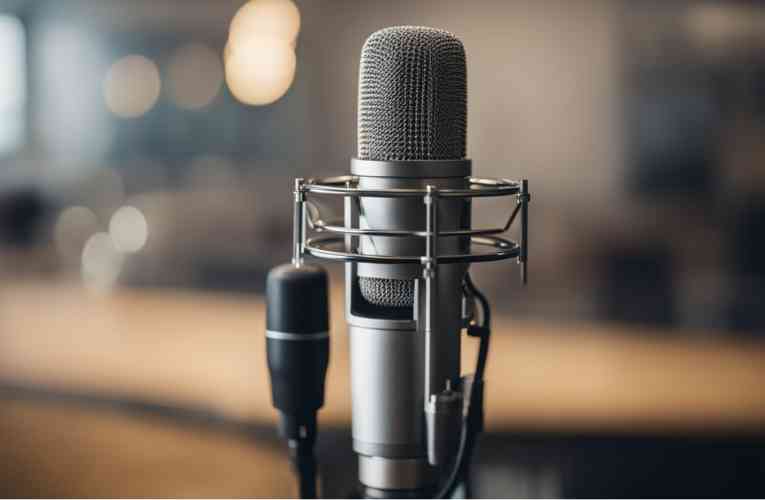Is your condenser mic sounding muffled? Don’t worry, you’re not alone. It’s a common issue that many people face while recording audio. There are several reasons why your mic might sound muffled, and this article will cover them in detail.
From technical issues with the microphone to recording environment characteristics, we’ll explore all the possible reasons why your condenser mic might be sounding muffled. We’ll also discuss the sound interface and software settings that can affect the quality of your recordings.
By the end of this article, you’ll have a better understanding of what causes a muffled sound in your condenser mic and how you can troubleshoot the issue. So, let’s dive in and explore the reasons why does my condenser mic sound muffled.
Key Takeaways
- A muffled sound in your condenser mic can be caused by various factors, including technical issues with the microphone, recording environment characteristics, and sound interface and software settings.
- Troubleshooting steps can help you identify and fix the issue, such as cleaning the mic, adjusting the mic’s position, and checking the cables and connections.
- To avoid a muffled sound in your condenser mic, make sure to choose the right microphone for your recording needs, use a pop filter to reduce plosives, and record in a quiet environment with good acoustics.
Table of Contents
ToggleWhy does my condenser mic sound muffled?

If you’re experiencing muffled sound from your condenser mic, there are a few reasons why this could be happening. Here are some of the most common causes:
Incorrect Microphone Placement
One of the most common reasons for muffled sound is incorrect microphone placement. If the microphone is too far away from the sound source, the sound will be weak and muffled.
On the other hand, if the microphone is too close to the sound source, it can cause distortion and muffled sound. To get the best sound quality, make sure your microphone is positioned correctly.
Faulty or Low-Quality Cables
Faulty or low-quality cables can also cause muffled sound. If your cables are damaged, they can cause interference and weaken the sound quality.
Make sure you’re using high-quality cables that are in good condition to avoid muffled sound.
Inadequate Power Supply
Another reason for muffled sound is inadequate power supply. If your microphone is not getting enough power, it can cause the sound to be weak and muffled. Make sure you’re using the correct power supply for your microphone to ensure the best sound quality.
Dust and Dirt Accumulation
Dust and dirt accumulation can also cause muffled sound. If your microphone has accumulated dust and dirt over time, it can affect the sound quality. Make sure you clean your microphone regularly to avoid muffled sound.
Related Posts:
Technical Issues with the Microphone

If your condenser microphone sounds muffled, it could be due to technical issues with the microphone itself. Here are some common technical issues that can cause your microphone to sound muffled:
Damaged Diaphragm
The diaphragm is a thin membrane inside the microphone that vibrates when sound waves hit it. If the diaphragm is damaged, it can cause your microphone to sound muffled.
This can happen if you drop your microphone or if you tap it too hard. To check if your diaphragm is damaged, gently tap the microphone with your finger and listen for any rattling sounds. If you hear any rattling, it could be a sign that your diaphragm is damaged.
Internal Wiring Problems
Internal wiring problems can also cause your microphone to sound muffled. If the wiring inside your microphone is loose or damaged, it can affect the sound quality.
This can happen if you drop your microphone or if you accidentally pull the cable too hard. To check if there are any internal wiring problems, gently wiggle the cable while listening to the microphone. If you hear any crackling or popping sounds, it could be a sign of internal wiring problems.
If you suspect that your microphone has technical issues, it is best to take it to a professional technician for repair. Attempting to fix technical issues on your own can cause further damage to your microphone.
Related Posts:
Recording Environment Characteristics
When it comes to recording with a condenser mic, the characteristics of your recording environment can have a significant impact on the quality of your sound. There are two main factors to consider: room acoustics and background noise.
Room Acoustics
The acoustics of your recording space can greatly affect the sound quality of your recordings. If your room has hard surfaces, such as tile or hardwood floors, and bare walls, your sound may be overly bright and echoey.
On the other hand, if your room is heavily carpeted and has lots of soft surfaces, your sound may be too muted and dull.
To achieve the best sound possible, you’ll want to find a space that has a balance of hard and soft surfaces. If you’re recording in a small room, you may want to consider using acoustic treatments, such as foam panels or diffusers, to help absorb excess sound and reduce echoes.
Background Noise
Background noise can also be a significant factor in the quality of your recordings. Common sources of background noise include traffic outside, air conditioning units, and even computer fans.
If you’re recording in a noisy environment, you may want to consider using a noise gate or noise reduction software to help minimize unwanted sounds.
It’s also important to make sure that you’re using the right microphone for your recording environment. Some microphones are better suited for recording in noisy environments than others, so be sure to do your research before making a purchase.
Related Posts:
Sound Interface and Software Settings
When it comes to recording with a condenser mic, the sound interface and software settings can play a significant role in the quality of your recordings. Here are a few common issues related to sound interface and software settings that can cause your condenser mic to sound muffled.
Incorrect Gain Levels
One of the most common reasons for a muffled sound is incorrect gain levels. The gain level controls the amount of amplification applied to the microphone signal, and if it’s too high or too low, it can result in a muffled sound. If the gain level is too high, the microphone will pick up too much background noise, resulting in a muffled sound.
On the other hand, if the gain level is too low, the sound will be too quiet, and you may need to increase the volume in post-production, which can result in a loss of quality.
To avoid this issue, make sure that your gain levels are set correctly. You can do this by adjusting the gain control on your sound interface or in your recording software. Start with a low gain level and gradually increase it until you get a good signal level without any distortion or background noise.
Improper Equalization
Another common issue related to sound interface and software settings is improper equalization. Equalization, or EQ, is the process of adjusting the balance between different frequency components in an audio signal.
If your EQ settings are incorrect, it can result in a muffled sound.
To fix this issue, you should check your EQ settings and adjust them as needed. Make sure that the low-frequency range is not too high, as this can result in a boomy or muddy sound. Similarly, make sure that the high-frequency range is not too low, as this can result in a dull or muted sound.
Troubleshooting Steps
If you’re experiencing muffled sound from your condenser microphone, there are a few troubleshooting steps you can take to identify and resolve the issue.
Testing with Different Equipment
First, try testing your microphone with different equipment. This can help you determine whether the issue is with your microphone or with other equipment in your setup.
For example, try plugging your microphone into a different audio interface or preamp. If the sound improves, the issue may be with your original equipment.
Professional Mic Inspection
If testing with different equipment doesn’t resolve the issue, consider having your microphone professionally inspected. A technician can identify any physical damage or defects that may be causing the muffled sound. They can also clean and repair your microphone as needed.
Keep in mind that some causes of muffled sound can be resolved with simple adjustments or cleaning, while others may require more extensive repairs or replacements. By following these troubleshooting steps, you can identify the source of the issue and take appropriate action to restore your microphone’s sound quality.
Conclusion
In conclusion, a muffled sound from your condenser mic can be caused by a variety of factors, ranging from dirt buildup to poor microphone positioning. To fix the issue, start by checking your power equipment, microphone choice, and distance from the mic.
If the problem persists, try cleaning your mic, adjusting your gain, and minimizing background noise. Remember to always handle your mic with care and avoid dropping it. With these tips, you should be able to achieve clear and crisp audio recordings with your condenser mic.
Frequently Asked Questions
What could be causing my condenser microphone to produce a muffled audio output?
There are a few reasons why your condenser microphone may sound muffled. One common reason is dirt buildup on the microphone diaphragm or capsule. This can be caused by exposure to dust, smoke, or other environmental factors. Another reason could be a problem with the recording software or hardware, such as a faulty audio interface or cable. Additionally, using the wrong power source or cable can also cause muffled sound output.
How can I improve the clarity of my condenser microphone’s sound?
To improve the clarity of your condenser microphone’s sound, you can try a few things. First, make sure that your microphone is properly positioned and oriented towards the sound source. You can also experiment with different microphone polar patterns to find the one that best suits your recording needs. Additionally, using a pop filter or windscreen can help reduce unwanted noise and improve clarity.
What steps should I take if my microphone’s sound quality degrades suddenly?
If your microphone’s sound quality suddenly degrades, there are a few things you can do to troubleshoot the issue. First, check the microphone cable and connections to make sure they are secure and not damaged. You can also try cleaning the microphone diaphragm or capsule with a soft cloth or brush. If the problem persists, try using a different microphone or recording device to see if the issue is with the microphone or the recording setup.
Why might my microphone sound like it’s underwater when used with my PC?
If your microphone sounds like it’s underwater when used with your PC, it could be due to a number of factors. One common reason is a problem with the audio drivers or settings on your computer. You can try updating the drivers or adjusting the audio settings to see if that helps. Additionally, using a different recording software or communication platform may also help resolve the issue.
How can I fix a muffled microphone issue on communication platforms like Discord?
If you are experiencing a muffled microphone issue on communication platforms like Discord, there are a few things you can try. First, check your microphone settings in the Discord app to make sure they are configured correctly. You can also try adjusting the input sensitivity or using push-to-talk mode to improve sound quality. If the issue persists, try using a different microphone or communication platform to see if that helps.
What should I check if my microphone’s volume output is insufficient or too low?
If your microphone’s volume output is insufficient or too low, there are a few things you can check. First, make sure that your microphone is properly connected and configured in your recording software or communication platform. You can also try adjusting the microphone gain or volume settings to increase the output level. Additionally, using a preamp or audio interface can help boost the signal and improve volume output.








